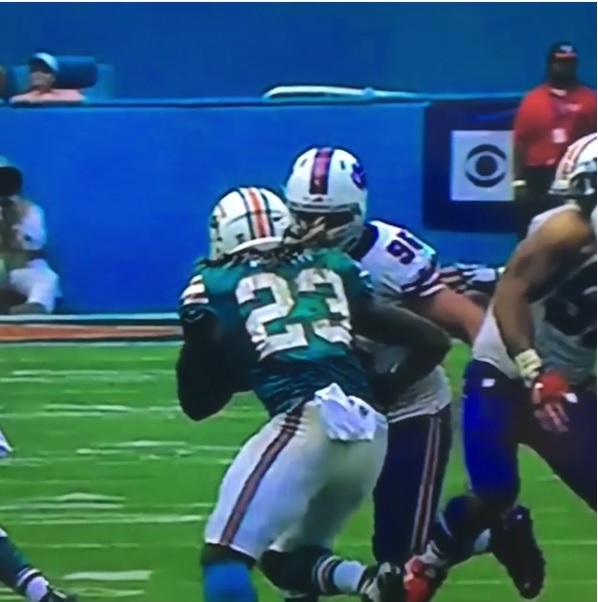
Jay Ajayi’s impressive display of balance against Pro-Bowl caliber defensive end Kyle Williams.
Define “balance” and “power.” Ask two talent analysts to do this and it’s one of the easier ways to take a conversation about football into the weeds.
There’s enough overlap between the two concepts that it can spawn debates about what belongs where. Without getting into too much detail, my basic definition of power is the ability to push piles, carry defenders, and run through wraps.
My basic definition of balance is the ability to maintain footing while attempting to change direction and bouncing off direct (straight-on) and indirect collisions. Jamaal Charles lacks great power, but his skill at turning a defender’s direct angle of pursuit into an indirect angle at the last possible moment so he can bounce off it with minimal impact is one of many things that made him a special runner.
Today’s examination of balance focuses on the mechanics and techniques of leverage and the intersection point of balance and power. Jay Ajayi’s confrontation with Kyle Williams is the setting for this lesson about evaluating a runner’s balance.
In addition to the way I define balance, I also score it based on successful confrontations against each level of the defense: linemen, linebackers, and defensive backs. The bigger the defender, the greater the difficulty of winning the confrontation.
Although the play below is filmed in slow motion, Kyle Williams is running at full speed down the line to meet the back head-on. In terms of winning a collision, Williams’ size and running start makes this situation one of the most demanding that a running back will face.
The first thing, Ajayi gets right is his pad level. He drops his pads just under the pads of Williams. Although his head drops with his pads, his chin doesn’t tuck into his chest.
This is important. Keeping that head up as much as possible through contact prevents the back from arching at an angle that makes a runner lose his balance.
Watch Ajayi on this play, and for the briefest moment you’ll see his head rise at the contact point and turn to the left. Tuck that chin, and you’re sinking like a stone regardless of contact.
More on that with a later example.
Ajayi also does the best he can to take the collision to the defender. Landing the first blow or meeting that blow at the same time helps.
So does limiting the contact to the inside shoulder, which Ajayi does as he works outside. The attack-first mentality, the angle of the attack, and the use of the inside shoulder all work to Ajayi’s favor.
Also note the crossover step from Ajayi after the hit. The move helps Ajayi transition from the contact to the edge while keeping his legs at shoulder width and his pads down hill.
Here’s the play in real time.
Ajayi has what I call starter-caliber balance. When he’s in position to execute with good technique, he can win head-on collisions against defensive linemen.
Backs with great balance and win collisions from odd angles and have a special knack for using their legs and upper body independently of the other. There’s also a strong motor-spatial awareness from these runners.
They possess skill for gauging how to maintain that shoulder-length leg width during a collision, changing direction, or even changing direction during a collision. Barry Sanders, Darren Sproles, and Marshawn Lynch are three players who instantly come to mind.
Ajayi isn’t this agile, but his ability to keep his feet at shoulder width after a lineman’s collision is strong work.
A player whose balance is lacking at the collision point when facing down defenders—even when he has built momentum—is Tevin Coleman. He can drag defenders and break wraps when working down hill at full speed, but that’s a form of power.
His lack of balance holds him back from becoming a consistently good back with special speed. Watch Coleman drop his head and tuck his chin before the contact with the linebacker.
He sinks well before the contact. Some of you may want to argue that Coleman worked under the defender and dropped to the ground on purpose.
But if you watch enough of his tape at Indiana and Atlanta, you’ll find a lot more examples like this one where it’s even clearer that Coleman’s pad level suffers because he drops his head. It’s one of a few reasons why his short-yardage and between-the-tackles game is not as good as Devonta Freeman’s.
Ajayi has no such problem. He’s a big back that runs like one.

